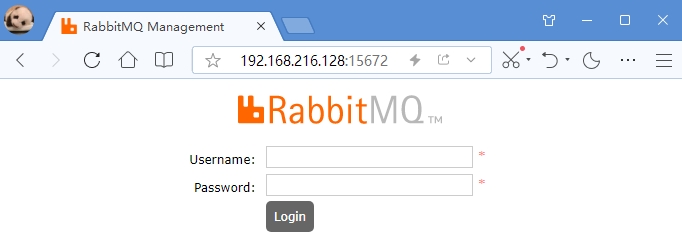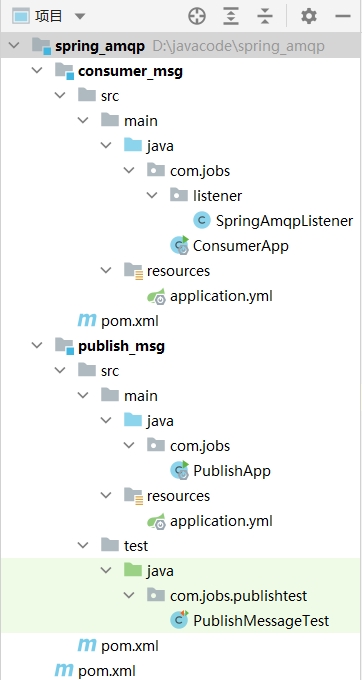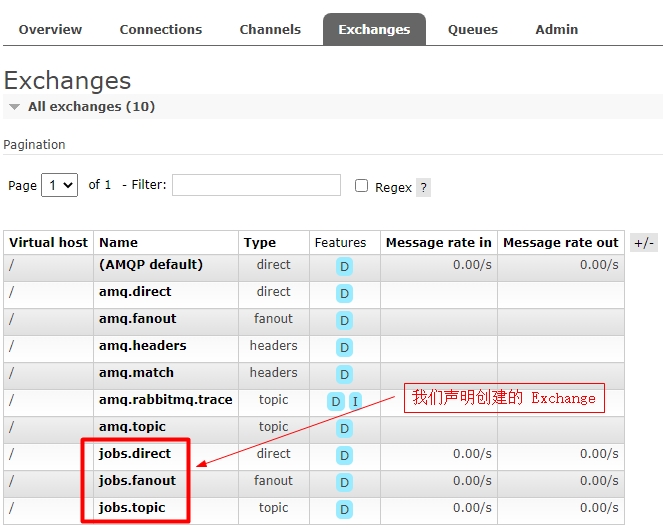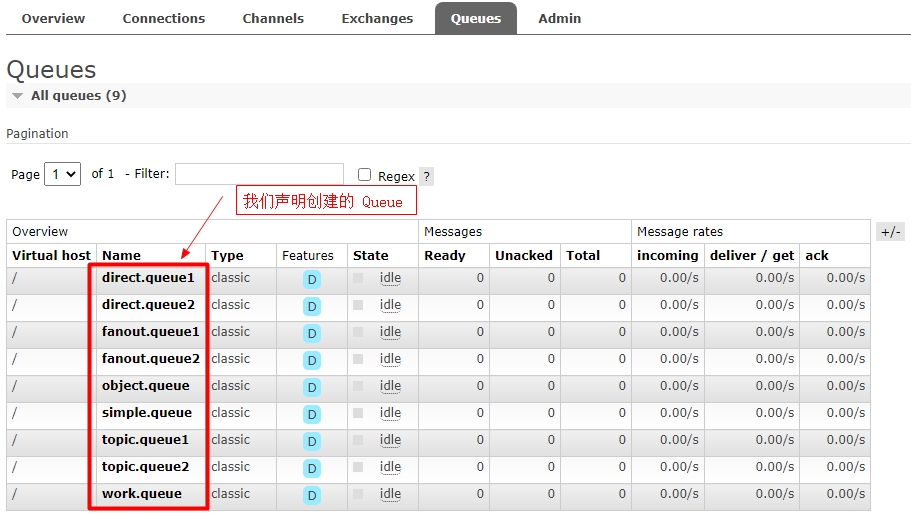使用 Spring AMQP 操作 RabbitMQ
RabbitMQ 采用 Erlang 语言开发,同时具有高可用性、高可靠性、消息低延迟,支持的多种开发语言的等优点,是当前比较流行的综合性最好的消息队列。当然有些杠精肯定会拿 RocketMQ 和 Kafka 等消息队列的相关性能跟 RabbitMQ 进行对比说事儿,这里不进行评价,你们这些杠精开心就好,说服一个人没有意义,把技术学到手,能够解决工作中的实际问题才是最重要的。
RabbitMQ 的官网地址:https://www.rabbitmq.com
AMQP 全称 Advanced Message Queuing Protocol(高级消息队列协议),是用于在应用程序之间传递业务消息的开放标准。该协议与语言和平台无关,很符合微服务中独立性的要求。Spring AMQP 是基于 AMQP 协议定义的一套 API 规范,提供了模板来发送和接收消息。默认情况下是基于 RabbitMQ 实现,能够使用 SpringBoot 进行自动装配,大大简化了程序代码的开发。
Spring AMQP 的官网地址:https://spring.io/projects/spring-amqp
本篇博客的 Demo 使用 Spring AMQP 操作 RabbitMQ,在博客最后提供源代码下载。
一、安装部署 RabbitMQ
之前的博客已经介绍了 Docker,为了简化安装过程,因此这里采用 Docker 安装启动 RabbitMQ
我安装 Docker 的虚拟机是 CentOS7,IP 地址是 192.168.216.128
在写本篇博客时,RabbitMQ 的官网上最新版本是 3.12 ,因此使用 Docker 安装的命令如下:
# 反斜杠(\)表示命令换行,因此命令太长,因此换行编写命令比较方便查看 docker run \ -e RABBITMQ_DEFAULT_USER=jobs \ -e RABBITMQ_DEFAULT_PASS=qwert \ --name mq \ --hostname mq \ -p 15672:15672 \ -p 5672:5672 \ -d rabbitmq:3.12-management
e 表示环境变量,RABBITMQ_DEFAULT_USER 表示默认用户名,RABBITMQ_DEFAULT_PASS 表示默认密码
hostname 表示主机名(这个很重要,因为 RabbitMQ 使用主机名来命名节点,当进行集群部署时用以区分每个节点,当然我们现在先使用单节点部署 RabbitMQ)。
p 表示宿主机映射 Docker 容器内部的端口,这里映射出 2 个端口(如果你防火墙没关闭的话,需要开放这 2 个端口),其中 5672 是程序连接发送和接收消息的端口,15672 是可视化界面的访问端口。
rabbitmq:3.12-management 是当前最新版本的 Docker 镜像名称。
以上操作都完成后,打开浏览器访问 http://192.168.216.128:15672,即可访问到可视化界面:

然后输入用户名 jobs ,密码 qwert 即可登录进去。可以查看到 RabbitMQ 的客户端连接、Exchange 交换机、Queue 队列、VirtualHost 虚拟主机等信息,可以直接进行可视化界面操作,有关 RabbitMQ 的相关概念介绍,这里不做过多介绍。
二、搭建工程
搭建一个父工程,包含 2 个 SpringBoot 子工程,分别用来发送和接收消息。

publish_msg 是发送消息的项目工程,其发送代码都是在测试类 PublishMessageTest 中编写。
consumer_msg 是接收消息的项目工程,其接收代码都是在 SpringAmqpListener 类中编写。
publish_msg 和 consumer_msg 中的 pom 文件由于需要使用相同的依赖,因此这两个工程的 pom 中没有引入任何依赖,它们所使用的依赖都是在父工程的 pom 中引入的,父工程的完成 pom 文件内容如下:
<?xml version="1.0" encoding="UTF-8"?> <project xmlns="http://maven.apache.org/POM/4.0.0" xmlns:xsi="http://www.w3.org/2001/XMLSchema-instance" xsi:schemaLocation="http://maven.apache.org/POM/4.0.0 http://maven.apache.org/xsd/maven-4.0.0.xsd"> <modelVersion>4.0.0</modelVersion> <groupId>com.jobs</groupId> <artifactId>spring_amqp</artifactId> <version>v1.0</version> <modules> <module>publish_msg</module> <module>consumer_msg</module> </modules> <packaging>pom</packaging> <parent> <groupId>org.springframework.boot</groupId> <artifactId>spring-boot-starter-parent</artifactId> <version>2.4.5</version> <relativePath/> </parent> <properties> <maven.compiler.source>8</maven.compiler.source> <maven.compiler.target>8</maven.compiler.target> </properties> <dependencies> <!--在此主要使用 lombok 自带的 log 方法--> <dependency> <groupId>org.projectlombok</groupId> <artifactId>lombok</artifactId> </dependency> <!--Spring AMQP 消息队列依赖--> <dependency> <groupId>org.springframework.boot</groupId> <artifactId>spring-boot-starter-amqp</artifactId> </dependency> <!--引入单元测试依赖--> <dependency> <groupId>org.springframework.boot</groupId> <artifactId>spring-boot-starter-test</artifactId> </dependency> <!--发送和接收消息,默认使用 jdk 的序列化进行消息转换, 引入该依赖,是为了配置消息转换使用 json 格式--> <dependency> <groupId>com.fasterxml.jackson.core</groupId> <artifactId>jackson-databind</artifactId> </dependency> </dependencies> </project>
三、消息接收者
之所以先介绍消息接收者,是因为在消息接收者代码中,能够通过注解声明出 Exchange 交换机和 Queue 队列,默认情况下是持久化的,因此只要先启动一次消费者程序,在 RabbitMQ 中就能够永久存储 Exchange 和 Queue ,后续就无所谓发送者和消费者的启动顺序了。首先我们先在 application.yml 中配置好 RabittMQ 的连接信息:
spring: rabbitmq: host: 192.168.216.128 port: 5672 username: jobs password: qwert virtual-host: / listener: simple: # 每次取 1 条消息进行消费,消费成功后再去取下一条消息 # 防止多个消费者被均匀分配消息,让消费能力强的消费者能够获取更多的消息 prefetch: 1
这里需要特别说明的是:最好配置上 prefetch,并且给予一个合理的值。如果不配置的话,当有多个消费者时,消费同一个消息队列时,不管消费者所在的机器性能如何,都会得到均匀数量的消息分配,这显然不是我们所期望的。我们肯定期望性能好的机器上的消费者能够多消费一些消息,因此配置上 prefetch 后,每个消费者都会先取出一定数量的消息消费完成后,再去获取下一批消息,这样就能够实现根据机器性能分配消息了。
下面列出 RabbitMQ 的 5 种消息队列的监听程序代码:
package com.jobs.listener; import org.springframework.amqp.core.ExchangeTypes; import org.springframework.amqp.rabbit.annotation.Exchange; import org.springframework.amqp.rabbit.annotation.Queue; import org.springframework.amqp.rabbit.annotation.QueueBinding; import org.springframework.amqp.rabbit.annotation.RabbitListener; import org.springframework.stereotype.Component; import java.util.Map; @Component public class SpringAmqpListener { /* SimpleQueue 接收消息代码 */ @RabbitListener(queuesToDeclare = @Queue(name = "simple.queue")) public void simpleQueuelistener(String msg) { System.out.println("接收到simple.queue的消息:" + msg); } //------------------------- /* WorkQueue 接收消息代码,这里写了 2 个监听程序,用以模拟 2 个消费者 */ @RabbitListener(queuesToDeclare = @Queue(name = "work.queue")) public void workQueueListener1(String msg) { System.out.println("listener【1】接收到work.queue消息:" + msg); } @RabbitListener(queuesToDeclare = {@Queue(name = "work.queue")}) public void workQueueListener2(String msg) { System.out.println("listener【2】接收到work.queue消息:" + msg); } //------------------------- /* fanout 接收消息代码,这里写了 2 个监听程序,用以模拟 2 个消费者 */ @RabbitListener(bindings = @QueueBinding( value = @Queue(name = "fanout.queue1"), exchange = @Exchange(name = "jobs.fanout", type = ExchangeTypes.FANOUT) )) public void listenerFanoutQueue1(String msg) { System.out.println("接收到fanout.queue【1】消息:" + msg); } @RabbitListener(bindings = @QueueBinding( value = @Queue(name = "fanout.queue2"), exchange = @Exchange(name = "jobs.fanout", type = ExchangeTypes.FANOUT) )) public void listenerFanoutQueue2(String msg) { System.out.println("接收到fanout.queue【2】消息:" + msg); } //------------------------- /* direct 接收消息代码,这里写了 2 个监听程序,用以模拟 2 个消费者 */ @RabbitListener(bindings = @QueueBinding( value = @Queue(name = "direct.queue1"), exchange = @Exchange(name = "jobs.direct", type = ExchangeTypes.DIRECT), key = {"big", "middle"} )) public void listenerDirectQueue1(String msg) { System.out.println("接收到direct.queue【1】消息:" + msg); } @RabbitListener(bindings = @QueueBinding( value = @Queue(name = "direct.queue2"), exchange = @Exchange(name = "jobs.direct", type = ExchangeTypes.DIRECT), key = {"small", "middle"} )) public void listenerDirectQueue2(String msg) { System.out.println("接收到direct.queue【2】消息:" + msg); } //------------------------- /* toppic 接收消息代码,这里写了 2 个监听程序,用以模拟 2 个消费者 toppic 表达式中的占位符:# 表示一个或多个单词,* 表示一个单词 */ @RabbitListener(bindings = @QueueBinding( value = @Queue(name = "topic.queue1"), exchange = @Exchange(name = "jobs.topic", type = ExchangeTypes.TOPIC), key = "china.#" )) public void listenerTopicQueue1(String msg) { System.out.println("接收到topic.queue【1】消息:" + msg); } @RabbitListener(bindings = @QueueBinding( value = @Queue(name = "topic.queue2"), exchange = @Exchange(name = "jobs.topic", type = ExchangeTypes.TOPIC), key = "#.news" )) public void listenerTopicQueue2(String msg) { System.out.println("接收到topic.queue【2】消息:" + msg); } //------------------------- /* 自定义接收消息代码,接收自定义对象的消息,通过配置消息转换,使用 Json 格式进行传输 */ @RabbitListener(queuesToDeclare = @Queue(name = "object.queue")) public void listenerObjectQueue(Map<String, Object> msg) { System.out.println("接收到object.queue的消息:" + msg); } }
启动消费者 SpringBoot 程序,就可以在可视化界面中,看到声明的 Exchange 和 Queue 了:


四、消息发送者
首先在 application.yml 中配置好 RabbitMQ 的连接信息:
spring: rabbitmq: host: 192.168.216.128 port: 5672 username: jobs password: qwert virtual-host: /
我们在测试类 PublishMessageTest 中编写为各种类型消息队列发送消息的代码:
package com.jobs.publishtest; import org.junit.jupiter.api.Test; import org.springframework.amqp.rabbit.core.RabbitTemplate; import org.springframework.beans.factory.annotation.Autowired; import org.springframework.boot.test.context.SpringBootTest; import java.util.HashMap; import java.util.Map; @SpringBootTest public class PublishMessageTest { @Autowired private RabbitTemplate rabbitTemplate; //给 SimpleQueue 类型的消息队列发送消息 @Test public void SendMsgToSimpleQueue() { String queueName = "simple.queue"; String message = "hello,simple.queue"; rabbitTemplate.convertAndSend(queueName, message); } //给 WorkQueue 类型的消息队列发送消息, //WorkQueue 实际上也是 SimpleQueue 类型的消息队列,只不过有多个消费者来接收消息而已 @Test public void SendMessageWorkQueue() { String queueName = "work.queue"; String message = "hello,work.queue__"; for (int i = 1; i <= 20; i++) { rabbitTemplate.convertAndSend(queueName, message + i); } } //给 Fanout 类型的消息队列发送消息 @Test public void sendFanoutExchange() { String exchangeName = "jobs.fanout"; String message = "打雷了,下雨了,快来收衣服了"; rabbitTemplate.convertAndSend(exchangeName, "", message); } //给 Direct 类型的消息队列发送消息 @Test public void sendDirectExchange() { String exchangeName = "jobs.direct"; String message1 = "hello,big"; rabbitTemplate.convertAndSend(exchangeName, "big", message1); String message2 = "hello,middle"; rabbitTemplate.convertAndSend(exchangeName, "middle", message2); String message3 = "hello,small"; rabbitTemplate.convertAndSend(exchangeName, "small", message3); } //给 Topic 类型的消息队列发送消息 @Test public void sendTopicExchange() { String exchangeName = "jobs.topic"; String message1 = "hello,usa新闻"; rabbitTemplate.convertAndSend(exchangeName, "usa.news", message1); String message2 = "hello,china新闻"; rabbitTemplate.convertAndSend(exchangeName, "china.news", message2); } //发送自定义对象类型消息,这里的 object.queue 实际上是 SimpleQueue 类型的消息队列 @Test public void sendObjectMessage() { Map<String, Object> map = new HashMap<>(); map.put("name", "乔豆豆"); map.put("age", 39); rabbitTemplate.convertAndSend("object.queue", map); } }
最后我们启动消费者 SpringBoot 程序后,依次运行发送者 SpringBoot 程序中的测试类中的方法,查看控制台打印的内容验证运行成果。以上就是使用 Spring AMQP 操作 RabbitMQ 实现 5 种消息队列的消息发送和接收的程序代码,有兴趣的话可以上网查询一下使用原生 api 方法操作 RabbitMQ 的代码进行对比一下,可以发现 Spring AMQP 的代码要简单很多,非常容易。
本篇博客的 Demo 源代码下载地址:https://files.cnblogs.com/files/blogs/699532/spring_amqp.zip




【推荐】国内首个AI IDE,深度理解中文开发场景,立即下载体验Trae
【推荐】编程新体验,更懂你的AI,立即体验豆包MarsCode编程助手
【推荐】抖音旗下AI助手豆包,你的智能百科全书,全免费不限次数
【推荐】轻量又高性能的 SSH 工具 IShell:AI 加持,快人一步
· 阿里最新开源QwQ-32B,效果媲美deepseek-r1满血版,部署成本又又又降低了!
· 开源Multi-agent AI智能体框架aevatar.ai,欢迎大家贡献代码
· Manus重磅发布:全球首款通用AI代理技术深度解析与实战指南
· 被坑几百块钱后,我竟然真的恢复了删除的微信聊天记录!
· AI技术革命,工作效率10个最佳AI工具